Main battle tank Panzer 68 Erprobungsträger (Switzerland)
The medium tank Pz 68 was an improved version of the previous Pz 61, which, in turn, was a deep upgrade of the older Pz 58. Thus, the general features of the appearance of the latest serial armored vehicles were identified in the mid-fifties and since then have not undergone significant changes. In this case, the sixties were a period of rapid development of armored vehicles. In particular, it was at this time that the newest main tanks appeared, which had a lot of advantages over the technology of previous generations. However, such progress mainly passed by the Swiss tank building.
Being a development of an older vehicle, the serial medium tank Pz 68 had homogeneous reservations with a thickness of up to 120 mm and carried a rifled gun of the caliber 105 mm. By the standards of the early seventies, it was no longer possible to obtain high combat effectiveness. Theoretical modeling of the battle of Pz 68 tanks and the Soviet T-72 showed that the Swiss car has minimal chances to emerge victorious from the collision. As a result, the army required new military equipment with enhanced characteristics that meet the requirements of the current time.
It is noteworthy that the obsolescence of the Panzer 68 tank became apparent by the mid-seventies, but until a certain time a radical upgrade of the existing machine was not planned. The fundamental decision to start such a project was made only in the early eighties. According to some information, by this time the military department began to consider the option of purchasing foreign-made tanks.
It was decided to carry out another modernization of the existing medium tank, the purpose of which was to significantly improve the basic characteristics. By these or other improvements, the serial car was proposed to be transferred to another class. Due to the growth of security and firepower, the medium tank had to become the main one. The development of a deep modernization project was once again entrusted to the design bureau Eidgenössische Konstruktionswerkstätte (EKW), who had previously created both the Pz 68 tank and the previous machines. The construction of a new technology was planned to be entrusted to K + W Thun.
The new project received the working designation Panzer 68 Erprobungsträger ("Pz 68, testing machine"). This name is sometimes abbreviated to Pz 68ET. In addition, some sources use the “extended” name Pz 68 Erprobungsträger M-0911, however in this case the serial number of the prototype is added to the official designation of the project. It should be noted that all such designations are equivalent and can not lead to confusion.
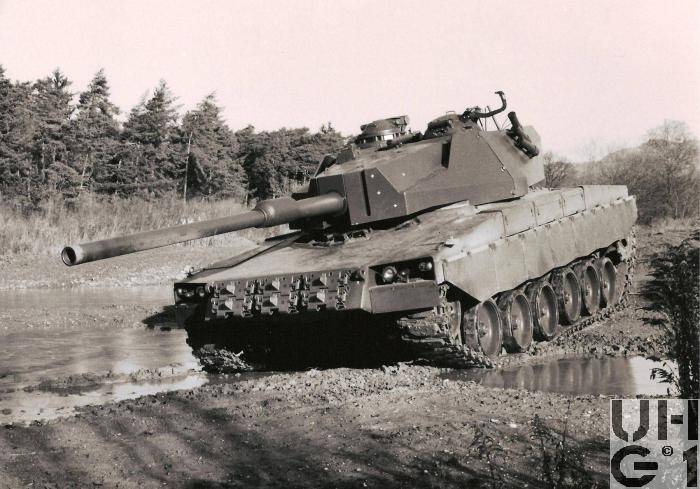
Prototype at the site. Photo Militaerfahrzeuge.ch
The main claims to the serial medium tank concerned the lack of protection and firepower. It was also necessary to update the weapons control tools. Mobility and other parameters were not planned to be changed for reasons of simplification of the project and economy. In connection with the emergence of such requirements, it was decided to carry out a deep modernization of the existing sample with the processing of part of the main units. Other structural elements could remain unchanged. To obtain the required characteristics, it was necessary to change the design of the frontal part of the hull and create an updated tower with reinforced weaponry.
The Pz 68 / 75 tank or the Grosser Turm, which was mass-produced from the 1978 of the year, was chosen as the basis for an improved armored vehicle. It differed from the previous machines of its family by some technical and technological modifications, as well as by a larger tower. The dimensions of the latter made it possible to install the L7 cannon without any problems and, with the adoption of certain measures, made it possible to use a more powerful and larger gun.
Back in the sixties, the first foreign tanks with enhanced combined armor went into the series. In the Pz 68ET project, the Swiss engineers decided to use just such a way to increase the resistance of the frontal projection. According to the available data, it was proposed to retain the existing frontal part of the body, but at the same time to supplement it with large amplification modules. Due to the lack of need and the risk of unacceptable weight gain, the combined booking should not be used on the sides and stern of the hull.
A new metal assembly of welded construction was installed on top of the cast curved body. He had a large sloping top sheet with a rear opening for the driver's hatch. In front, the inclined sheet was connected to a smaller part installed at a different angle. Under it was another narrow sheet. A filler of an unknown type was placed between the body’s own armor and the structure installed on it. Additional armor box differed significant size and prominently come forward. For a slight increase in the level of protection, it was proposed to transport spare tracks on the middle front sheet.
Tanks of previous models had hull sides with a characteristic protruding upper part. This structural element has also been modified to increase the level of protection. In addition, new covers have appeared over the fenders, which are located on the same level as the upper frontal part. Under them was placed lighting equipment. The side drawers for the property and the aft covers of exhaust pipes were retained, but their shape has changed markedly. Now they provided a smooth conjugation of the horizontal roof and vertical sides. On the sides hung screens covering the top of the chassis.
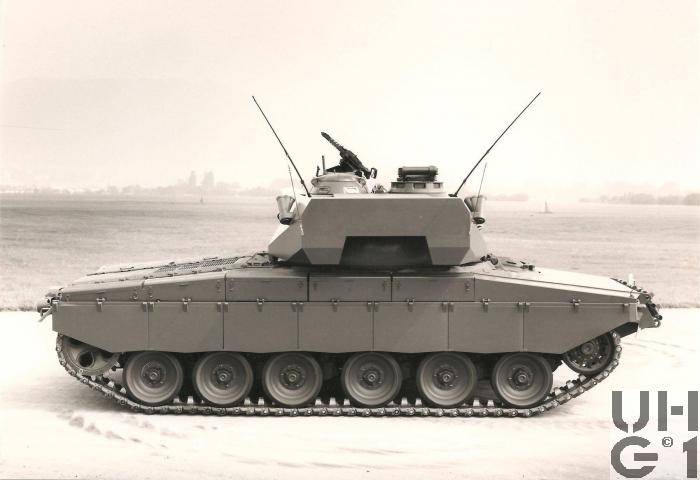
Tank with a deployed tower. Well visible niche in the stern, necessary for the convenience of the driver. Photo Militaerfahrzeuge.ch
The hull retains the existing shape of the aft. The tilted rear roof was still used, with a large number of individual access hatches. The cast protection of the stern had fastenings for various units, including supports for holding the gun in the stowed position.
According to some sources, tower defense was improved by the use of additional outboard reservations. In addition to the existing dome, the Pz 68 Erprobungsträger tank received oversized attachments with sophisticated outer circuits formed by many flat panels. The existing frontal armor was complemented by a large polygonal casing, in the center of which there was a rectangular cutout for moving the gun and its narrow mask. The forehead of the front casing was formed by two beveled sheets of small width, with which the cheekbones consisting of two parts were joined. An interesting feature of these parts are large cuts to ensure the operation of optical devices. The stern parts of the sides consisted of two parts installed at different angles. The stern leaf was U-shaped and was tilted back.
The layout of the tank remained classic. In front of the hull were a department of management, fuel tanks, etc., in the center - the fighting compartment, in the stern - the engine compartment. Significant changes in the layout of the project were not envisaged due to the desire to simplify the update of equipment.
In the aft compartment, the Mercedes-Benz MB 837 Ba-500 hp 660 hp engine still had to fit. Hydrodynamic transmission, proposed in a previous modernization project of existing Pz 68 tanks, was connected to the engine. She provided six forward and reverse gears. The auxiliary power plant in the form of a Mercedes Benz OM 636 VI E engine with an 38 hp power, connected to an electric generator, was also kept in the stern. For greater ease of maintenance, both engines, transmission, etc. mounted on a common frame, forming a single power unit.
The chassis of the medium tank has not undergone significant modifications. Each board was still used a set of six road wheels with individual suspension on the disc springs. In this case, the first prototype of the tank received rollers of different designs. The two front pairs of rollers were characterized by the presence of perforations, reducing their weight. In front of the hull were sloths, in the stern - driving wheels. Supporting rollers of small diameter remained. Like the base tank, the Pz 68ET was supposed to use a 520 mm wide caterpillar with rubber pads.
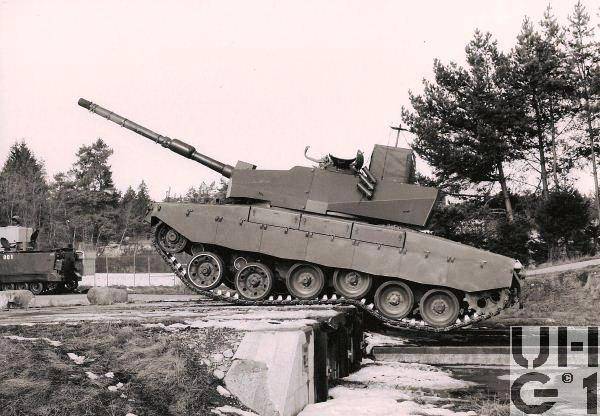
The tank climbs the wall. Photo Militaerfahrzeuge.ch
105-mm rifled gun Royal Ordnance L7 has long been considered one of the best tank guns, but by the early eighties, its potential in the fight against modern tanks has decreased dramatically. Because of this, in the new project Pz 68 Erprobungsträger it was proposed to use a more powerful 120-mm smooth-bore gun. The Swiss company K + W Thun was supposed to produce such systems under a license acquired from the German company Rheinmetall.
The need to install a more powerful gun, characterized by large size, led to some alteration of the existing fighting compartment. In addition, it took a certain way to change the design of the tower, originally created for smaller caliber guns. The tasks were successfully solved, so that the upgraded tank received a smooth-bore gun caliber 120 mm. Used trunk length 44 caliber, equipped with an ejector. The gun had a semi-automatic shutter and used unitary loading.
The ammunition of the main gun was able to bring to 56 projectiles. On 22 unitary shots were placed in the side tanks-racks. Another 12 cells for ammunition were on the floor of the fighting compartment. Any means of automatic filing of shots to the gun were not provided. As in previous tanks, the loader had to prepare the cannon for a shot.
At one installation with a gun mounted twin machine gun MG 51 / 71 caliber 7,5 mm. The second such machine gun was proposed to be kept on the roof of the tower, on the installation of the loader hatch. General ammunition consisted of 5200 cartridges. Ready-to-use ammunition consisted of 200 and 400 cartridges. Several additional boxes with ribbons for 1000 cartridges were stored at the walls of the fighting compartment. Under the floor of the latter there was room for 3600 cartridges.
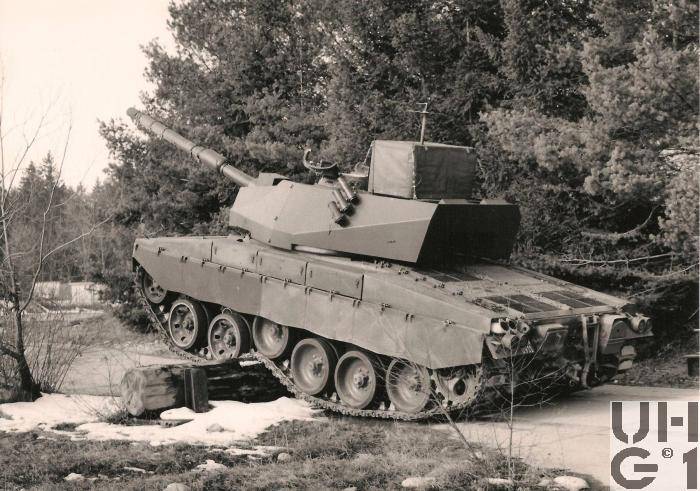
Overcoming obstacles. Photo Militaerfahrzeuge.ch/ center]
On the sides of the tower, it was planned to install two groups of three 76-mm smoke grenade launchers each. Six grenades were charged before the battle, as many shots were stored in the styling of the fighting compartment. On the roof of the tower, between the hatches of the crew, the signal mortar Bofors Lyran caliber 71 mm was kept. 12 ammunition for it was also transported inside the hull.
The new modernization project used a standard set of sighting devices. The commander and the gunner had both periscope and telescopic sights. In addition, the base Pz 68 borrowed a ballistic computer, equipment for firing at moving objects and an analog fire control system that combines all these devices. To improve the accuracy of fire, a two-plane stabilizer was used.
The composition of the crew during the modernization has not changed. The Pz 68 Erprobungsträger was driven by four tank crews. In front of the case housed the driver's workplace. It retained all existing equipment and was completed with a standard hatch. The lid was folded up and back, allowing you to observe on the march. In a combat situation used several periscopes. A specific feature of the new tank was the enlarged front of the turret, which blocked the driver's hatch. Because of this, access to the department of management was provided only when the tower was deployed to the side or back. Since the aft niche of the unfolded tower was also above the driver, it had to provide a large cut-out, allowing the hatch to be opened. Driving with the open hatch and the gun forward was eliminated.
Three other tankers were in the fighting compartment. The gunner and the commander were placed to the right of the gun, a common hatch in the roof was intended for them. The commander could observe the terrain with the help of a low turret with periscopes around the perimeter. The second hatch was located at the left side and was intended for loader. He was also equipped with viewing devices, but at the same time carrying a machine gun installation.
Through the use of new protection and more powerful weapons The upgraded tank turned out to be larger and heavier than its predecessor. The length with the forward cannon grew to 9,5 m, width - 3,14 m, height - 2,85 m. Combat weight reached 42 t. This led to some reduction in power density, but driving performance, in general, did not change. The maximum speed of the Pz 68ET on the highway reached 55 km / h, on rough terrain it was possible to accelerate to 30 km / h. Fuel tanks with a total capacity of 710 l allowed to drive at least 400-420 km. The tank retained the ability to overcome various obstacles, including ditches and fords.
[Center]
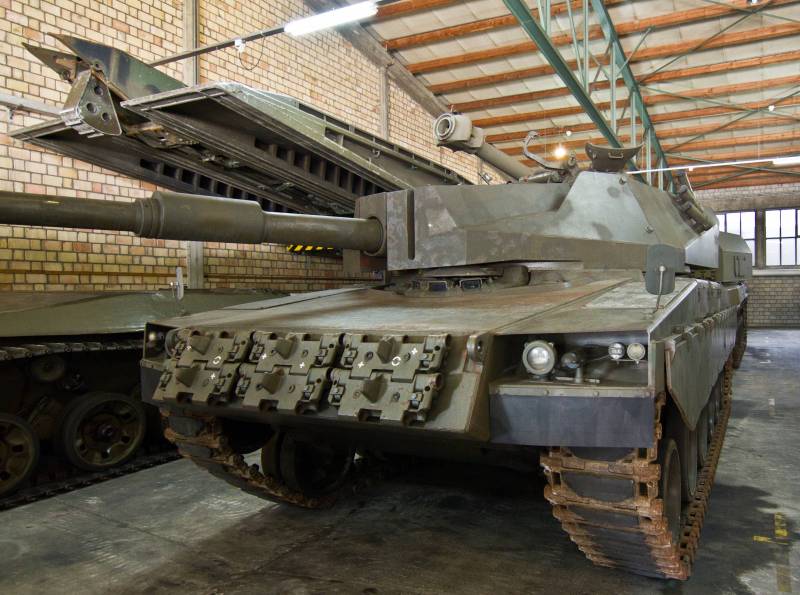
Museum Pz 68ET. You can consider the construction of an additional reservation. Photo by Massimo Foti / Flickr.com
In 1984, the K + W Thun plant (city of Thun) built the first prototype of a promising tank, which was to prove the correctness of the ideas and solutions used. The prototype was built on the basis of the serial tank Pz 68 / 75. Over the existing armor, additional elements of combined protection were installed, as well as new boxes, covers, etc. were mounted. In the future, this approach to construction could significantly reduce the cost of upgrading the existing fleet of armored vehicles. The first and only experienced Panzer 68 Erprobungsträger received the serial number M-0911.
Coming to the landfill, an experienced tank Pz 68ET confirmed the design characteristics. The use of enhanced frontal protection, consisting of two relatively thick armor plates and filler, gave a noticeable increase in survivability. Such armor could protect a tank, at a minimum, from common 100-105 mm guns. At the same time, it was quite simple in production and could be installed on existing machines without serious alteration.
At the time of the appearance of the Pz 68 Erprobungsträger 120-mm tank, a smoothbore gun from Rheinmetall was one of the newest and most advanced models of its class. When using cumulative or sub-caliber shells, the gun reliably hit armored vehicles with homogeneous armor, and also showed good penetration characteristics of the combined protection. Thus, the level of firepower of the newest Swiss tank could be compared with modern foreign models, first of all, carrying the same weapon.
Having shown good parameters of firepower and protection, the upgraded tank showed noticeable problems with mobility. As a result of the installation of additional armor and 120-mm guns, the combat mass increased to 42 t, and the power density, in turn, fell to 15,7 hp. per ton. With such characteristics, the armored vehicle could still reach a maximum speed on the highway at the level of the base Pz 68, however, it accelerated much slower. Even more serious, the lack of power manifested itself in rough terrain. In such conditions, the tank accelerated more slowly and with great effort overcame obstacles, lagging behind in similar characteristics from its predecessor.
After testing the only prototype, the Pz 68ET project was in a very difficult situation. Some of the tasks were successfully solved and certain characteristics were raised, but at the cost of this was the deterioration of other parameters, which are also of great importance. In its present form, a well-defended and armed, but insufficiently mobile, main tank did not represent much interest for the army. An obvious way out of this situation was the refinement of the project using a more powerful engine, allowing to bring mobility to an acceptable level. However, such an improvement in the armored car required additional costs, and it also had to take an indefinite amount of time.
Even with the most successful development of further events, an improved main tank with a more powerful engine could come to the test no earlier than 1985-87. Further tests would be required, and the serial construction of new equipment (or the modernization of existing tanks) would start only at the beginning of the next decade. All this time, the army of Switzerland would have to continue the operation of outdated equipment with insufficient characteristics. Similar problems should also be taken into account when drawing up plans for the foreseeable future.
The Federal Military Department and the Armed Forces Command familiarized themselves with the current situation and made a decision. The project of the main tank Panzer 68 Erprobungsträger was of particular interest to the army, but not in its current form. Further development of the tank with the subsequent launch of mass production / modernization was considered impractical. The purchase of foreign armored vehicles was considered much more advantageous from the point of view of finance, technology and operation. Soon a contract appeared for the supply of German-made Leopard 2 main battle tanks. The first cars of this type were purchased in finished form, after which the licensed assembly began. In the Swiss army, German tanks received the designation Panzer 87.
After completion of the tests and the failure of the military, the only built tank Pz 68ET with the serial number M-0911 was transferred to the military museum of Burgdorf. There, the car remains to this day and is demonstrated in one pavilion to another armored Swiss development, including with medium tanks Pz 61 and Pz 68. Available information suggests that the tank was not dismantled and still remains in good condition.
In the sixties of the last century, the leading countries created a number of the newest main battle tanks, exceeding all existing armored vehicles in their parameters. Similar progress over time was reflected in the Swiss tank building. Existing machines no longer met the requirements, which is why an attempt was made to significantly improve their performance. The project is the conversion of a medium tank Pz 68 in the main Pz 68 Erprobungsträger had some positive results, but could not solve all the problems because of a number of specific limitations. The result of this was sad for the industry: Switzerland no longer attempted to create its own main tank, preferring imported equipment to the domestic one.
On the materials of the sites:
http://militaerfahrzeuge.ch/
http://massimocorner.com/
http://tanks-encyclopedia.com/
http://militaryfactory.com/
http://sturgeonshouse.ipbhost.com/
http://strangernn.livejournal.com/
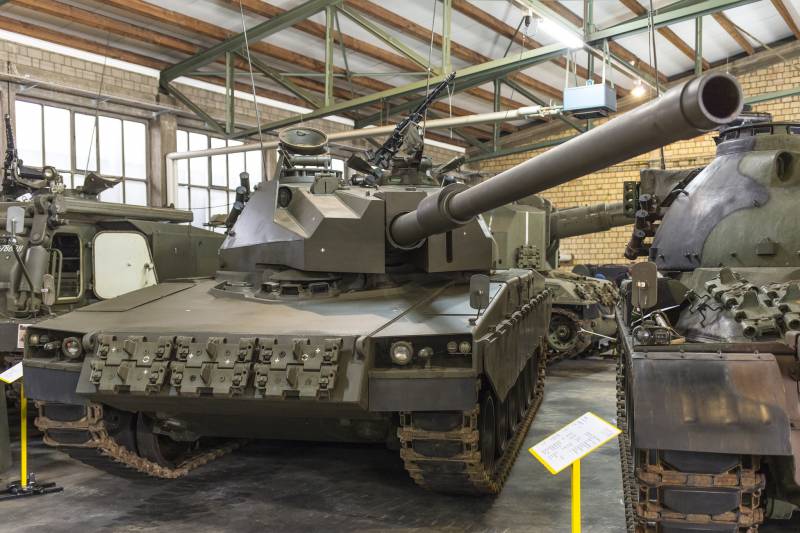
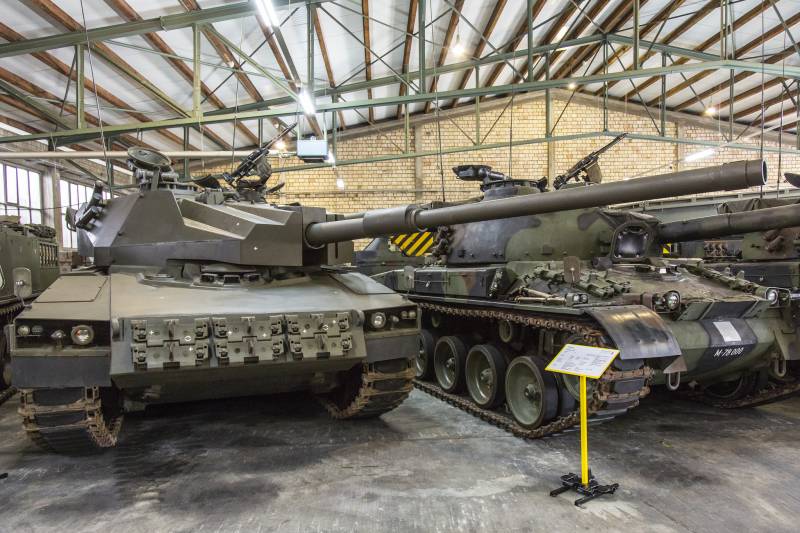
Information